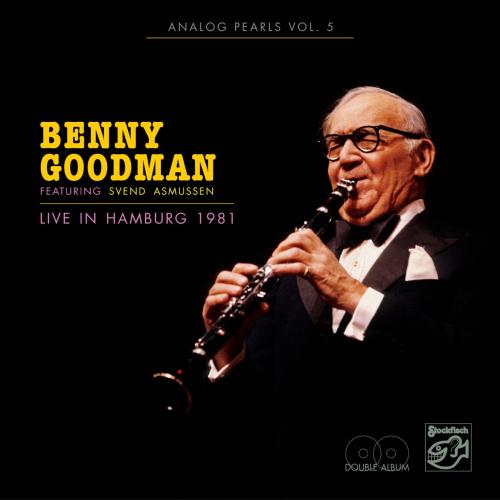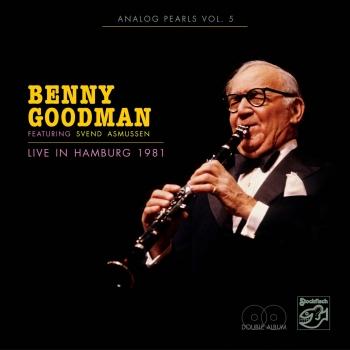
Live in Hamburg 1981 (Remastered) Benny Goodman
Album Info
Album Veröffentlichung:
2020
HRA-Veröffentlichung:
28.08.2020
Das Album enthält Albumcover Booklet (PDF)
- 1 After You've Gone (Live) 05:30
- 2 If I Had You (Live) 03:07
- 3 Avalon (Live) 05:03
- 4 Careless Love (Live) 05:46
- 5 The Days of Wine and Roses (Live) 06:31
- 6 Hush-A-Bye (Live) 05:22
- 7 Sweet Georgia Brown (Live) 05:02
- 8 I Want to Be Happy (Live) 05:05
- 9 Here's That Rainy Day (Live) 02:54
- 10 Oh, Lady Be Good (Live) 04:59
- 11 Nuages (Live) 06:14
- 12 Airmail Special (Live) 05:08
- 13 On the Sunny Side of the Street (Live) 02:59
- 14 Don't Be That Way (Live) 04:29
- 15 Body and Soul (Live) 04:21
- 16 How High the Moon (Live) 03:49
- 17 The World Is Waiting for the Sunrise (Live) 04:20
- 18 Sing, Sing, Sing (With a Swing) (Live) 06:55
- 19 Goodbye (Live) 02:10
- 20 It's Easy to Remember (Live) 02:20
Info zu Live in Hamburg 1981 (Remastered)
Mehr als ein Sammlerstück: Benny Goodmann live in Hamburg: Der Nestor des Swing und eine Garde des nordeuropäischen Jazz 1981 im Congresscentrum Hamburg Northeim, im Mai 2020. Der Mitschnitt des letzten Auftritts von Benny Goodman auf deutschem Boden im Rahmen der NDR-Sonntagskonzerte ist weit mehr als ein neu entdecktes Sammelstück für die Fans des ewig jungen Swings amerikanischer Tradition. Günter Pauler gelang auf Goodmans letzter Europatournee 1981 im Hamburger Congresscentrum mit kleinem Aufnahme-Besteck ein spannendes, zum Ende sogar berührendes Tondokument des auch im Alter immer noch auf Weltniveau spielenden Goodmans. Das Zusammenspiel zwischen (damals) jungen dänisch/belgischen Musikern und dem Altmeister der Jazz-Klassik auf der großen Bühne des Hamburger CCH überzeugt mit großem gegenseitigem Spielverständnis und Klasse.
Gemeinsam mit einem Quintett aus dänischen Spitzenmusikern, darunter der 2017 verstorbene Svend Asmussen (vio, vib) und dem belgischen Gitarristen Philip Catherine, verbindet sich Goodmans eher traditionell perlende Klarinette mit pulsierender europäischer Jazzpraxis zu einem musikalisch überraschend interessanten Ergebnis. Goodman entlockt dem weltweiten Kanon des Jazz von After You´ve Gone bis zum legendären Sing, Sing, Sing auch nach tausenden von Konzerten noch spannende Momente. Ob im intimen Duett mit dem dänischen Violonisten und Vibraphonisten Svend Asmussen oder zurückgenommen im Tutti bei Lady Be Good : Der Altmeistert läßt seinen viel jüngeren Begleitmusikern viel Raum zur eigenen Interpretation und führt das Quintett doch immer wieder auf das Tanzparkett des amerikanischen Swing der 30er Jahre zurück. Goodmans Vermächtnis: It´s Easy To Remember , ein Mann, eine Klarinette, eine Melodie. Ein selig swingender Abend, perfekt und stimmungsvoll eingefangen. (Axel Janssen)
Benny Goodman, Klarinette
Svend Asmussen, Violine, Vibraphon
Philip Catherine, Gitarre
Claes Crona, Klavier
Mads Vinding, Bass
Bjarne Rostvold, Schlagzeug
Digitally remastered
Benny Goodman
For a kid who liked jazz, Chicago was a great town to grow up in. Musicians had begun working their way north from New Orleans about the turn of the century, and by the early 1920s giants like "Jellyroll" Morton, Sidney Bechet, "King" Oliver and Louis Armstrong were playing in Chicago and making history.
Kids who paid attention to this development were going to make history themselves in a few more years - Bud Freeman, Davie Tough, Eddie Condon, Milt Mesirow (Mezz Mezzrow), Gene Krupa, "Muggsy" Spanier, Jimmy McPartland, Jess Stacy - and a kid in short pants who played the clarinet.
Benny Goodman was only 10 when he first picked up a clarinet. Only a year or so later he was doing Ted Lewis imitations for pocket money. At 14 he was in a band that featured the legendary Bix Beiderbecke. By the time he was 16 he was recognized as a "comer" as far away as the west coast and was asked to join a California-based band led by another Chicago boy, Ben Pollack.
Goodman played with Pollack's band for the next four years. His earliest recording was made with Pollack, but he was also recording under his own name in Chicago and New York, where the band had migrated from the west coast. In 1929, when he was just 20, Benny struck out on his own to become a typical New York freelance musician, playing studio dates, leading a pit orchestra, making himself a seasoned professional.
By 1934 he was seasoned enough to be ready for his first big break. He heard that Billy Rose needed a band for his new theatre restaurant, the Music Hall, and he got together a group of musicians who shared his enthusiasm for jazz. They auditioned and got the job.
Then Benny heard that NBC was looking for three bands to rotate on a new Saturday night broadcast to be called "Let's Dance," a phrase that has been associated with the Goodman band ever since. One band on the show was to be sweet, one Latin, and the third hot. The Goodman band was hot enough to get the job, but not hot enough to satisfy Benny. He brought in Gene Krupa on drums. Fletcher Henderson began writing the arrangements - arrangements that still sound fresh more than a half century later. And the band rehearsed endlessly to achieve the precise tempos, section playing and phrasing that ushered in a new era in American music. There was only one word that could describe this band's style adequately: Swing. www.bennygoodman.com
Booklet für Live in Hamburg 1981 (Remastered)










